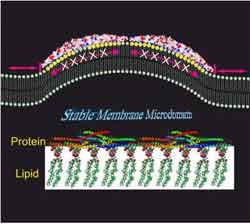Freeze! A protein group affecting lipid dynamics at cell membranes discovered

BAR proteins can create stable lipid microdomains at cell membranes.<br><br>Credit: Hongxia Zhao<br>
BAR domain proteins are among the central membrane-sculpting proteins in all eukaryote cells. Studies by Pekka Lappalainen laboratory at Institute of Biotechnology, University of Helsinki, Finland, now reveal that BAR domain proteins not only bend membranes, but also generate extremely stable lipid microdomains by inhibiting the lateral diffusion of certain lipids nearly completely.
In a new study published in Cell Reports, Hongxia Zhao working in the Lappalainen laboratory discovered that all BAR domain proteins induce strong clustering of phosphoinositides, which are important lipids involved in regulating protein functions and cellular signalling.
Her studies also revealed that BAR domains assemble into extremely stable scaffolds on the membrane. Surprisingly, mobility of phosphoinositides was nearly completely frozen in these BAR domain induced lipid platforms. These extremely stable protein-lipid scaffolds may contribute to diverse cellular processes by generating lipid phase boundaries at the tips of the BAR domain scaffolds.
Furthermore, the membrane microdomains induced by BAR domains are expected to function as diffusion barriers, which may for example trap membrane-associated receptor and cargo molecules at the endocytic bud.
Thus, distribution and mobility of specific lipid species at the plasma membrane appears to precisely regulated by membrane-associated proteins. Hongxia Zhao is now continuing studies on regulation of lipid dynamics as an Academy Research Fellow at University of Helsinki.
Media Contact
More Information:
http://www.helsinki.fiAll latest news from the category: Life Sciences and Chemistry
Articles and reports from the Life Sciences and chemistry area deal with applied and basic research into modern biology, chemistry and human medicine.
Valuable information can be found on a range of life sciences fields including bacteriology, biochemistry, bionics, bioinformatics, biophysics, biotechnology, genetics, geobotany, human biology, marine biology, microbiology, molecular biology, cellular biology, zoology, bioinorganic chemistry, microchemistry and environmental chemistry.
Newest articles

Sea slugs inspire highly stretchable biomedical sensor
USC Viterbi School of Engineering researcher Hangbo Zhao presents findings on highly stretchable and customizable microneedles for application in fields including neuroscience, tissue engineering, and wearable bioelectronics. The revolution in…

Twisting and binding matter waves with photons in a cavity
Precisely measuring the energy states of individual atoms has been a historical challenge for physicists due to atomic recoil. When an atom interacts with a photon, the atom “recoils” in…

Nanotubes, nanoparticles, and antibodies detect tiny amounts of fentanyl
New sensor is six orders of magnitude more sensitive than the next best thing. A research team at Pitt led by Alexander Star, a chemistry professor in the Kenneth P. Dietrich…





















